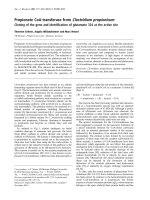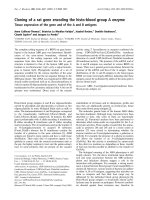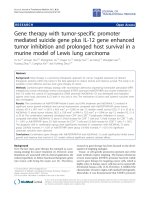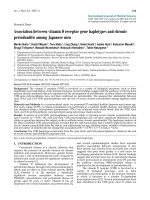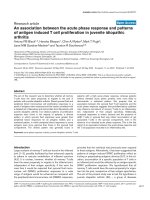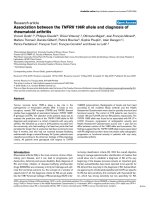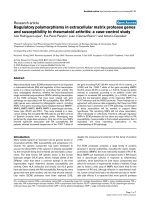No association between RS821616 of DISC1 gene and susceptibility to schizophrenia in a Vietnamese population
Bạn đang xem bản rút gọn của tài liệu. Xem và tải ngay bản đầy đủ của tài liệu tại đây (4.02 MB, 5 trang )
Journal of military pharmaco-medicine No7-2017
NO ASSOCIATION BETWEEN RS821616 OF DISC1 GENE AND
SUSCEPTIBILITY TO SCHIZOPHRENIA
IN A VIETNAMESE POPULATION
Dang Tien Truong*; Nguyen Duy Bac*; Pham Minh Dam*; Tran Hai Anh*
SUMMARY
Objectives: To clarify a possible association between schizophrenia (SZ) and single
nucleotide polymorphism (SNP) rs821616 within disrupted in schizophrenia 1 (DISC1) gene in a
Kinh population in Vietnam. Methods: We genotyped rs821616 of DISC1 gene using direct
sequencing method. Results: Our case-control analysis in 201 participants (100 schizophrenic
patients and 101 healthy controls of Kinh ethnicity) found no significant difference in allele
frequencies and genotyping distributions between case and control groups. Conclusion: The
results providing an initial evidence that SNP rs821616 has no association to susceptibility for
SZ in a limited population of Kinh ethnicity in Vietnam.
* Keywords: Schizophrenia; Single nucleotide polymorphism; rs821616; DISC1.
INTRODUCTION
Schizophrenia (SZ) is a severe mental
disorder influencing multiple brain functions.
The heritability is accounted about 80% in
SC, with around 10-fold risk increase in
first degree relatives. Genetics in SZ
has long been assumed as a major
component basing on family and adoption
studies. Substantial evidence from genetics
studies supports an important role of
disrupted in schizophrenia 1 (DISC1) in
regulation for neural development [6, 8],
and of single nucleotide polymorphism
(SNP) rs821616 (Ser704Cys) within DISC1
gene in pathophysiology of SZ [1].
Ser704Cys
associated
to
poor
concentration in SZ patients [3], frontal
and temporal gray matter reduction [9],
and lower hippocampal volume [2], etc.
However, results on DISC1 from different
populations have been inconsistent,
especially between and among European
and Asian populations [2, 3, 4]. Since
there have still no DISC1 related data
from Vietnamese people, this early study
aimed to: Elucidate a possible association
between SZ and rs821616 of DISC1 gene
in a Kinh population in Vietnam.
SUBJECTS AND METHODS
1. Subjects.
100 schizophrenic patients and 101
healthy controls of Kinh ethnicity were
participated in this case-control study.
Schizophrenia cases were collected from
Department of Psychiatry of 103 Hospital,
Vietnam Military Medical University. The
patients were diagnosed by criteria of
Diagnostic and Statistical Manual of
Mental Disorders, 4th Edition (DSM-IV).
* Vietnam Military Medical University
Corresponding author: Tran Hai Anh ()
Date received: 04/07/2017
Date accepted: 17/08/2017
48
Journal of military pharmaco-medicine no7-2017
2. Methods.
Kits used in the study including Qiagen
Blood Mini kit, Qiagen master mix kit,
QIA quick PCR Purification Kit (Qiagen,
Germany), and Bigeye Terminator 3.1
and POP 4 (ABI, USA).
* SNP genotyping:
Peripheral blood samples were collected
from all 201 subjects. Genomic DNA was
extracted using Qiagen Blood Mini kit,
following the manufacturer’s protocol and
stored at -20oC. The obtained product
containing SNP was amplified using
polymerase chain reaction (PCR) method.
The PCR reaction was carried out in a total
volume of 50 µL containing 50 - 100 ng
genomic DNA as the template, 0.2 µM of
each primer (synthesized by IDT, USA),
and Master mix Qiagen kit 1X. PCR
amplification was performed in a Master
Cycler® thermal cycler (Eppendorf, Germany)
with an initial denaturation step at 98°C
for 15 minutes, followed by 30 cycles of 95°C
for 30 seconds, 58°C for 30 seconds, 72°C
for 60 seconds, and a final extension step
at 72°C for 5 minutes. The primer sequence
for the forward and reverse primers were
5’-TGACCAGCTGACTTTTAGCC-3’ and
5’- AAGTTTATATGCTCAATGGGAAGC-3’,
respectively. The PCR products were
separated on 2% agarose gel. PCR
products were perfricated and genotyped
by Bigdye Terminator 3.1. and sequenced
on ABI 3130XL.
* Statistical analysis:
Hardy-Weinberg equilibrium (HWE) for
the SNP was assessed in both cases and
controls. Frequencies and alleles of
genotypes were calculated and compared
using a chi-square test, and Fisher exact
test.
* Ethical approval:
This study was approved by the ethics
review committee of Vietnam Military
Medical University.
RESULTS AND DISCUSSION
1. Demographics of participants.
Some characteristics of subjects were showed in table 1.
Table 1: Demographics of participants.
Groups
Age
Gender (n, %)
(mean ± SD)
Male
female
SZ (100)
34.58 ± 11.64
61 (61.00)
39 (39.00)
Control (101)
32.91 ± 6.44
63 (62.38)
38 (37.62)
p = 0.21
2
X = 0.04; p = 0.84
The results in table 1 showed that there was no different mean age and gender
between SZ and control groups, respectively p = 0.21 and p = 0.84.
49
Journal of military pharmaco-medicine No7-2017
2. Results of genotyping of rs821616.
Genomic DNA extracted and purified, then amplified to PCR products for further
genotyping analyses is demonstrated in figure 1.
A
B
Figure 1: Artwork of DNA agarose electrophoresis results in SZ group (A)
and control group (B).
Identical lanes in figure 1 illustrated that PCR products were specific and sufficient
for genotyping.
The results for genotyping of rs821616 (homozygous and heterozygous types) are
shown in figure 2.
Figure 2: Peaks (arrows) of heterozygous (AT) and homozygous genotypes (TT, AA)
of the SNP in SZ samples.
Test for Hardy Weinberg equilibrium showed that genotypes in the patient (X2 = 1.29)
and control (X2 = 1.22) groups were consistent with HWE (p > 0.05).
Genotyped allele frequencies of rs821616 in DISC1 gene is shown in table 2.
50
Journal of military pharmaco-medicine no7-2017
Table 2: Allele frequencies of rs821616 in DISC1 gene.
Groups
n
SC
200
Control
202
Allele frequency (n)
A
T
0.94 (188)
0.06 (12)
0.90 (182)
0.10 (20)
2
X = 2.09; p = 0.15; OR = 0.58; 95%CI 0.25 - 1.29
The results in table 2 showed no significant difference in allele frequencies between
2
the patient and control groups (X = 2.09; p = 0.15).
The results of genotype prevalence of rs821616 in DISC1 is shown in table 3.
Table 3: Genotypic distribution of the rs821616 of the DISC1 gene.
n
(%)
AA
AT
TT
SC
100
(49.75)
89
(52.35)
10
(33.33)
1
(100.00)
Control
101
(50.25)
81
(47.65)
20
(66.67)
0
(0.00)
Total
201
(100.00)
170
(100.00)
30
(100.00)
1
(100.00)
Groups
Genotype frequency n (%)
p = 0.074
Genotyping of rs821616 in table 3
showed no significant difference in genotypic
distribution between the total patients and
controls (p = 0.074).
Our results were in accordance with the
results of previous studies on rs821616
and SZ in Korean and Malaysian
populations [3, 4]. On the other hand,
there were some results showed an
association between rs821616 and SZ in
Chinese Han [7] and in Caucasian
populations [2]. Nevertheless, a study on
a Korean population also indicated that
DISC1 variation is associated with the
poor concentration phenotype of SZ [3].
While rs821616 was reported as having
an association with SZ in the Chinese
Han population [7], but found no such
association in a study on a Malaysian
population [4]. Several studies reported a
relation of symptoms, reduction of gray
matter and this rs821616 [2, 3, 9]. Those
lines of evidence supports the role of
rs821616 within DISC1 gene in pathology
of schizophrenia [5, 8]. To our knowledge,
the present work is the first study in our
country investigating SNP rs821616 and
SC, and found no marked association
between them. This finding is limited due
to the relative small sample size and
genetic stratification of an initial
investigation. Therefore, further studies
with a larger size would be needed to
firmly elucidate effects of SNP generally,
and rs821616 (Ser704Cys), specifically in
SZ.
51
Journal of military pharmaco-medicine No7-2017
CONCLUSION
Single nucleotide polymorphism rs821616
tentatively seems no association to
susceptibility for SZ in a limited population
of Kinh ethnicity in Vietnam.
REFERENCES
1. Balu D.T, Coyle J.T. Neuroplasticity
signaling pathways linked to the pathophysiology
of SZ. Neurosci Biobehav Rev. 2011, 35 (3),
pp.848-870.
M.A, Penninx B.W, Veltman D.J, Aleman A.
DISC1 gene and affective psychopathology: a
combined structural and functional MRI study.
J Psychiatr Res. 2015, 61, pp.150-157.
6. Palo O.M, Antila M, Silander K, Hennah
W, Kilpinen H, Soronen P, Tuulio-Henriksson
A, Kieseppä T, Partonen T, Lönnqvist J,
Peltonen L, Paunio T. Association of distinct
allelic haplotypes of DISC1 with psychotic and
bipolar spectrum disorders and with underlying
cognitive impairments. Hum Mol Genet. 2007,
16 (20), pp.2517-2528.
2. Callicott J.H, Straub R.E, Pezawas L,
Egan M.F, Mattay V.S, Hariri A.R, Verchinski
B.A, Meyer-Lindenberg A, Balkissoon R,
Kolachana B, Goldberg T.E, Weinberger D.R.
Variation in DISC1 affects hippocampal
structure and function and increases risk for
SZ. Proc Natl Acad Sci. USA. 2005, 102 (24),
pp.8627-8632.
7. Qu M, Tang F, Yue W, Ruan Y, Lu T,
Liu Z, Zhang H, Han Y, Zhang D, Wang F,
Zhang D. Positive association of the
disrupted-in-SZ-1 gene (DISC1) with SZ in the
Chinese Han population. Am J Med Genet B
Neuropsychiatr Genet. 2007, 144B (3),
pp.266-270.
3. Kim H.J, Park H.J, Jung K.H, Ban J.Y,
Ra J, Kim J.W, Park J.K, Choe B.K, Yim S.V,
Kwon Y.K, Chung J.H. Association study of
polymorphisms between DISC1 and SZ in
a Korean population. Neurosci Lett. 2008,
430 (1), pp.60-63.
8. Shao L, Lu B, Wen Z, Teng S, Wang L,
Zhao Y, Wang L, Ishizuka K, Xu X, Sawa A,
Song H, Ming G, Zhong Y. Disrupted-in-SZ-1
(DISC1) protein disturbs neural function in
multiple disease-risk pathways. Hum Mol
Genet. 2017, doi: 10.1093/hmg/ddx147.
4. Norlelawati A.T, Kartini A, Norsidah K,
Ramli M, Tariq A.R, Wan Rohani W.T.
Disrupted-in-SZ-1 SNPs and susceptibility to
SZ: Evidence from Malaysia. Psychiatry
Investig. 2015, 12 (1), pp.103-111.
9. Trost S, Platz B, Usher J, Scherk H,
Wobrock T, Ekawardhani S, Meyer J, Reith
W, Falkai P, Gruber O. DISC1 (disrupted-inSZ 1) is associated with cortical grey matter
volumes in the human brain: a voxel-based
morphometry (VBM) study. J Psychiatr Res.
2013, 47 (2), pp.188-196.
5. Opmeer E.M, van Tol M.J, Kortekaas R,
van der Wee N.J, Woudstra S, van Buchem
52

